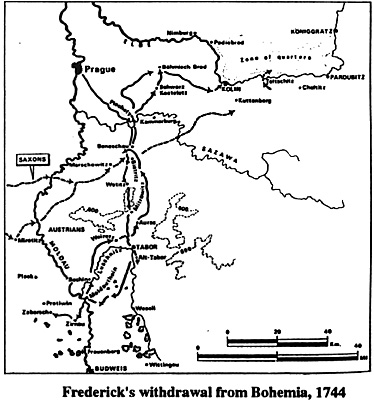Frederick Invades Bohemia
Having crossed the Rhine into Alsace, the Austrian army of Prince Charles was vulnerable to a Prussian counterstroke in Bohemia. Frederick advised King Louis XV of France that the Prussian army would accelerate its mobilization by several weeks and invade Bohemia in mid-august. On August 15, 1744, a Prussian army of 80,000 men advanced towards Bohemia in three columns. The Austrians could muster no more than 18,000, but the majority of these were Croat and Hungarian irregulars. Under the skilful guidance of General Batthyany, they managed to avoid open battle, choosing instead the hit and run tactics that suited them so well. Batthyany hoped to buy enough time for Prince Charles to return ftom the Rhine.
As for the Prussians, Frederick demanded and received free passage for two of his columns through Saxony. The royal army, commanded by Frederick, was 40,000 strong and advanced up the south or left bank of the Elbe River, past Dresden and Pirna in Saxony. Its objective was the Austrian magazine at Leitmeritz in Bohemia. There it would await the second column of 16,000 men commanded by Prince Leopold of Anhalt Dessau, which was advancing from Bautzen to Zittau and down the Iser River valley to Leitmeritz.
A third force of 16,000 men under Marshal von Schwerin would descend out of Silesia and Glatz to cross the Elbe at Koniggratz. These forces would be reinforced by 480 river barges moving up the Elbe from Magdeburg in Prussia to Pirna in Saxony. The escort guard was commanded by General von Bonin. All told, 80,000 Prussians descended on Bohemia, with Prague as its principle objective. The city was defended by a force of 4,000 regulars (largely from the invalid corps) and 10,000 militia under the command of General Harsch. Prague surrendered to the Prussians on September 15,1744 after a week's siege.
Frederick's withdrawal from Bohemia, 1744
Two days later, the Prussians advanced south towards Tabor near the Austrian border at the urging of the French. A defensive occupation of northern Bohemia would have been the prudent thing to do, but Frederick marched boldly towards Vienna, leaving behind the supply magazines on which his army depended. He expected to live off the land instead. The move also left his right flank open to a counterattack from Bavaria through the Bohemian mountains. Food would soon become a problem as the civilians were openly hostile to Prussian occupation. They would hide or burn all foodstuffs, rather than sell them to the Prussians. Long supply lines were easy prey for the thousands of Croats who roamed the Bohemian countryside at will.
Prince Charles Returns to Bohemia
Charles was already marching back from Alsace. The French failed to stop him at the Rhine and allowed him to cross Bavaria unmolested By the first of October, Charles was in Bohemia, at Pilsen, waiting to join a Saxon army of 20,000. Charles, or more specifically his field general, Marshal Traun, avoided a decisive engagement with the Prussians. Traun positioned the Austro-Saxon army across Frederick's supply lines in northern Bohemia and relied on hunger , weather and desertion to do his work for him. Frederick had one opportunity to attack the allied army at Marschowitz,but a reconnaissance of the position revealed that it was too strong to attack, so Frederick wisely retired on Prague instead.
Frederick hoped to salvage something out of the campaign by retiring to winter quarters on the north bank of the Elbe River in Bohemia. However, these plans were upset when the Austrians crossed the Elbe at Telschitz and threatened the left flank of the entire army. By the end of November, the Prussians were withdrawing to Silesia. The Bohemian campaign had been a complete failure for Frederick. Charles and Traun had skillfully avoided the decisive battle that Frederick sought, while a lack of supplies, hussar raids and wholesale desertions had shrunk the Prussian army to half its original size.
Map: Frederick's Withdrawal from Bohemia

More Second Silesian War
- Second Silesian War: Introduction
Second Silesian War: Bohemia 1744
Second Silesian War: Silesia 1745
Back to Seven Years War Asso. Journal Vol. VI No. 2 Table of Contents
Back to Seven Years War Asso. Journal List of Issues
Back to Master Magazine List
© Copyright 1992 by James E. Purky
This article appears in MagWeb (Magazine Web) on the Internet World Wide Web.
Other military history articles and gaming articles are available at http://www.magweb.com